-
 New product -45%FSA Powerbox power meter BCD 110 mm
New product -45%FSA Powerbox power meter BCD 110 mm- €296.99
- €539.99
-
 New product UsedLeft crank Shimano Ultegra 170 mm
New product UsedLeft crank Shimano Ultegra 170 mm- €64.99
-
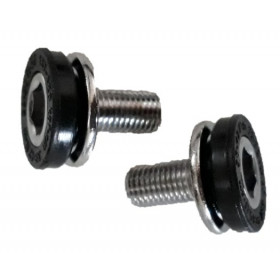 New product2 screws for cranks axle square
New product2 screws for cranks axle square- €4.49
-
 New product UsedFSA Gossamer crankset BB386EVO 172.5 mm
New product UsedFSA Gossamer crankset BB386EVO 172.5 mm- €54.99
-
 UsedShimano Exage 500EX crank
UsedShimano Exage 500EX crank- €8.99
-
 New product -43%Right crank FSA CK-745 Yamaha motor
New product -43%Right crank FSA CK-745 Yamaha motor- €29.64
- €52.00
-
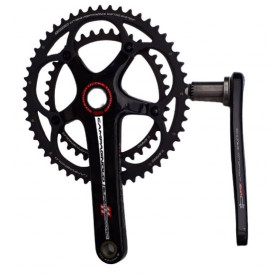 New product -28%Campagnolo Super Record 11s ultra torque crankset 52 39 teeth
New product -28%Campagnolo Super Record 11s ultra torque crankset 52 39 teeth- €647.99
- €899.99
-
 Used NewFSA Gossamer cranks 170 mm
Used NewFSA Gossamer cranks 170 mm- €36.99
-
 UsedCampagnolo Mirage crankset
UsedCampagnolo Mirage crankset- €9.99
-
 UsedRight crank Shimano FC-R600
UsedRight crank Shimano FC-R600- €19.99
-
 UsedRotor 3DF crankset
UsedRotor 3DF crankset- €64.99
-
 New productSingle chainring 32-tooth crankset
New productSingle chainring 32-tooth crankset- €55.99
-
 New productStronglight 107 right crank
New productStronglight 107 right crank- €49.99
-
 UsedLeft crank Shimano Dura ace
UsedLeft crank Shimano Dura ace- €44.99
-
 UsedFSA SLK light BB386 crankset 170 mm 34 50 teeth
UsedFSA SLK light BB386 crankset 170 mm 34 50 teeth- €139.99
-
 New productFSA Omega crankset
New productFSA Omega crankset- €54.99
-
 UsedCampagnolo Record 12s ultra torque crankset 52 36 teeth 172.5 mm
UsedCampagnolo Record 12s ultra torque crankset 52 36 teeth 172.5 mm- €189.99
-
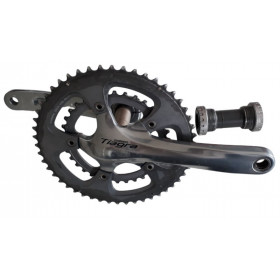 UsedShimano Tiagra crankset FC-4650 50-34
UsedShimano Tiagra crankset FC-4650 50-34- €59.99
-
 New productRight crank Shimano Ultegra FC-6503 172.5 mm
New productRight crank Shimano Ultegra FC-6503 172.5 mm- €18.99
-
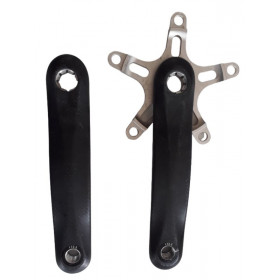 New productRoad bike carbon cranks 172.5 mm
New productRoad bike carbon cranks 172.5 mm- €49.99
-
 UsedLeft crank FSA K force light carbon
UsedLeft crank FSA K force light carbon- €19.99
-
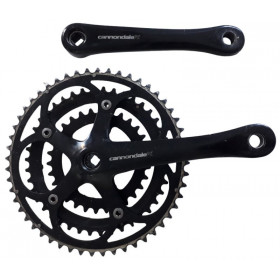 UsedCannondale PX crankset 172.5 mm
UsedCannondale PX crankset 172.5 mm- €34.99
-
 UsedShimano Dura ace FC-7800 crankset 172.5 mm 10s
UsedShimano Dura ace FC-7800 crankset 172.5 mm 10s- €89.99
-
 UsedCarbon left crank FSA carbon pro team 180 mm
UsedCarbon left crank FSA carbon pro team 180 mm- €9.99
-
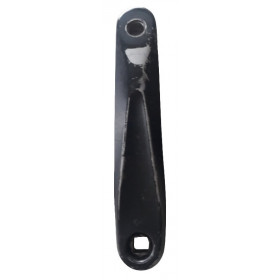 UsedLeft crank FSA 170 mm
UsedLeft crank FSA 170 mm- €4.99
-
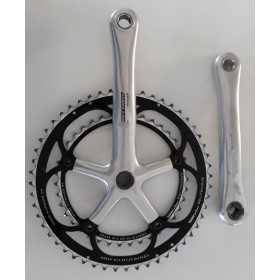 UsedCampagnolo Record crankset 10s double used
UsedCampagnolo Record crankset 10s double used- €54.99
-
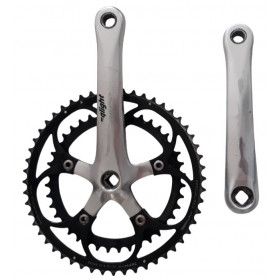 UsedVintage stronglight crankset 170 mm
UsedVintage stronglight crankset 170 mm- €24.99
-
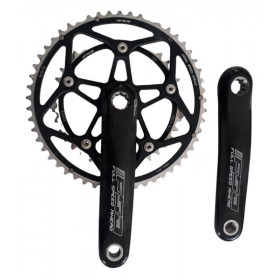 New productCranks FSA carbon 170 mm 39 53
New productCranks FSA carbon 170 mm 39 53- €79.99
-
Campagnolo Record crank 10s double
- €18.99
-
Shimano 105 left crank
- €19.99
-
Left crank Shimano Tiagra
- €19.99
-
Left crank Shimano Ultegra FC-R8000 172.5 mm
- €29.99
-
Sram force crankset 170 mm BB30 10s
- €139.99
-
Shimano Sora right crank triple FC-3503 50-39-30
- €34.99
-
Shimano 105 crankset
- €39.99
Showing 1-35 of 35 item(s)
Road bike crankset: everything you need to know to choose wisely
The road bike crankset is one of the central components of a road bike drivetrain. It plays a key role in performance, cadence, and pedaling efficiency. Whether you're a casual rider or a seasoned competitor, choosing the right road bike crankset allows you to tailor your effort to your riding style and the terrain you encounter. But how do you navigate the vast array of available models? Here's a comprehensive overview of the key features and specifications you should know.
What is a road bike crankset ?
The road bike crankset, also referred to as road crankset or crankset for road bike, is a crucial element of the road bike transmission system. It typically consists of three main components: the chainrings, the crank arms (left and right), and—on many modern models—an integrated spindle that passes through the bottom bracket.
The bicycle crankset is mounted on both sides of the frame at the bottom bracket shell, using a bottom bracket (either threaded or press-fit, depending on the standard). This bottom bracket houses bearings that ensure smooth and efficient rotation of the crank-arm and chainring assembly. When pedaling, the rider applies force to the road bike pedals, which rotate the crank arms. This motion drives the chainrings, which in turn rotate the road bike chain. The chain transmits power to the cassette cogs on the rear wheel, propelling the bike forward.
However, the crankset doesn't work in isolation. It constantly interacts with the rest of the road bike drivetrain: the chain, cassette, front and rear derailleurs, and the shift levers. This synergy allows smooth gear changes, adapts to variations in terrain, and optimizes effort whether climbing or riding on flat roads. A well-adjusted front derailleur is essential to ensure clean, precise shifting between chainrings.
The crankset also determines your available gear ratios, which refer to the relationship between the number of teeth on the chainrings and those on the cassette cogs. That’s why choosing the right crankset format (compact, semi-compact, or standard) directly affects performance, cadence, and energy management.
Finally, the road crankset is subject to significant mechanical stress. It must be stiff, lightweight, and durable. The materials used—aluminum, carbon fiber, or sometimes high-end alloys—greatly influence the crankset’s strength, weight, and dynamic behavior on the bike.
The different types of road bike cranksets
Road bike cranksets are primarily available in three configurations, based on the number of teeth on the chainrings. This choice directly impacts your gear ratio, i.e., the combination of front chainring and rear cog, which determines pedaling difficulty and overall speed. Each crankset type is suited to a specific riding style:
1. Compact crankset (50/34 teeth)
Featuring a large 50-tooth chainring and a smaller 34-tooth inner ring, the compact crankset is a favorite among amateur cyclists and those who frequently ride on hilly or mountainous terrain.
It allows for a higher cadence even during climbs thanks to its easier gearing, while still offering solid versatility on flat roads. The compact setup is also ideal for long-distance rides or gran fondos, as it helps reduce muscle fatigue and allows for better energy management over time.
2. Standard crankset (53/39 teeth)
Traditionally used in competitive cycling, the standard crankset provides a higher gearing range. The 53-tooth big ring, paired with a tight-range cassette, enables cyclists to reach high speeds on flat terrain or descents.
However, it requires more muscular power, especially when climbing, and is not recommended for less-trained riders or those seeking easier pedaling. It remains the go-to choice for elite racers, powerful riders, and sprinters who prioritize speed and output.
3. Semi-compact crankset (52/36 teeth)
The semi-compact crankset offers a perfect middle ground between the compact and standard options. With a slightly smaller large ring (52 teeth) and a 36-tooth small ring, it delivers great versatility for regular cyclists who alternate between flat roads, climbs, and rolling terrain.
This setup is suitable for both training and racing, offering a well-balanced gear range that allows for efficient climbing as well as sustained speed on descents and flats without excessive spinning.
How to choose the right road bike crankset
Selecting the right road bike crankset should take several key factors into account:
-
Your fitness level: Beginner cyclists will benefit most from a compact crankset, which offers easier gearing for climbs and endurance rides.
-
The terrain you typically ride: Is your route mostly flat, rolling, or mountainous?
-
Your natural pedaling cadence: Some riders prefer a fast spin with a higher cadence, while others favor a slower, more forceful stroke.
-
Your drivetrain configuration: Especially the number of speeds on your cassette, which determines the range of possible gear combinations.
A proper match between your crankset, road bike chain, front derailleur, and bottom bracket ensures a smooth, quiet, and durable transmission system.
Pro tip: Don't overlook the value of expert advice or the manufacturer's recommendations for your groupset. Ensuring compatibility across all drivetrain components is essential for optimal performance.
Crank arm length and Q-factor: small details, big impact
When talking about a road bike crankset, most people focus on the chainrings or mounting type. Yet, two often-overlooked elements play a crucial role in comfort, pedaling efficiency, and injury prevention: crank arm length and Q-Factor.
Crank arm length: a biomechanical and physiological lever
Crank arm length — measured from the center of the bottom bracket to the center of the pedal axle — typically ranges from 165 mm to 175 mm, with special models as short as 160 mm or as long as 180 mm depending on rider needs.
This length directly influences the biomechanical leverage used to turn the road chainrings. Longer cranks generate more torque at lower cadences, which can be helpful for climbing or for powerful riders. Shorter cranks, on the other hand, allow for a higher cadence, reduce the range of motion, and improve pedaling fluidity — especially in an aerodynamic position.
Why does it matter?
A poorly chosen crank length can lead to knee, hip, or lower back pain, especially over long distances. The right choice depends on several factors: your height, leg length (inseam), pedaling style, and type of riding.
Q-Factor: optimizing lower body alignment
The Q-Factor is the horizontal distance between the outer surfaces of the crank arms at the point where the pedals attach. On road cranksets, this spacing is typically narrower (around 145–150 mm) than on mountain bike cranksets (often 160 mm or more) to promote a more aerodynamic position and better knee alignment.
A Q-Factor that is too wide can push the legs outward unnaturally, causing inefficient pedaling or even discomfort. Conversely, a Q-Factor that is too narrow can lead to hip tension or friction. The goal is to find a natural stance that suits your body structure while optimizing power transfer.
Good to know: Some pedal models come with axles of varying lengths, allowing you to fine-tune your Q-Factor without needing to replace the crankset.
Custom ergonomics for better performance
Crank length and Q-Factor aren't just technical specifications — they're critical setup elements that influence how your leg power is transmitted through the road bike crankset, chain, and the entire drivetrain system.
A well-matched configuration leads to smooth, powerful, and pain-free pedaling, whether you're a casual rider or a demanding cyclist. If you experience discomfort or want to maximize your efficiency, a professional bike fit can help you determine the ideal crank length and Q-Factor for your body.
Crankset materials and weight: balancing performance, stiffness, and budget
The road bike crankset is subject to significant mechanical stress. It must withstand the constant force applied by the rider’s legs, transmit power efficiently to the road bike chain, and maintain optimal stiffness to avoid energy loss. To meet these demands, manufacturers use a variety of materials, each offering distinct characteristics in terms of weight, strength, cost, and pedaling feel.
Aluminum: the ideal balance of weight, stiffness, and cost
Aluminum is the most commonly used material for mid-range road bike cranksets. It offers an excellent stiffness-to-weight ratio while remaining affordable. Crank arms are often CNC-machined or forged and sometimes hollowed out to further reduce weight.
Aluminum cranksets are valued for their reliability, durability, and reasonable cost. They are ideal for regular cyclists looking for a good balance between performance and price, without compromising the quality of their drivetrain.
Carbon: premium lightweight performance
Carbon cranksets are reserved for high-end models designed for racers and cyclists seeking maximum performance. This composite material is not only lighter than aluminum but also allows for greater design freedom to optimize both lateral stiffness and aerodynamics.
A carbon crankset, often paired with a titanium or lightweight aluminum spindle, can save several hundred grams from the total drivetrain, enhancing bike responsiveness — especially during accelerations, sprints, and climbs. However, this advanced technology comes at a higher cost and may be more vulnerable to impact damage.
Steel: vintage durability and specialized use
Steel, being denser and heavier, is rarely used in modern road cranksets due to its weight. It can still be found in vintage cranksets, city bikes with traditional drivetrains, or in touring and winter training setups where extreme durability is prioritized over weight.
While it offers exceptional longevity and high torsional resistance, its inertia makes it a less suitable choice for performance cycling, where weight savings are often a key concern.
Weight and responsiveness: every gram counts
In the world of road cycling, the weight of the crankset plays a crucial role in the overall feel and behavior of the bike—especially during sprints, climbs, and changes in pace. A lighter road bike crankset improves:
-
The overall responsiveness of the road drivetrain
-
The liveliness felt with each pedal stroke
-
Energy efficiency, by reducing the rotational inertia
However, lightness should never come at the expense of stiffness. A crankset that is too flexible can lead to power loss and a lag in power transfer to the chain and cassette. This not only affects performance but can also diminish the rider's sensation of control and precision.
That’s why high-end cranksets often combine advanced materials, aerodynamic and structural optimization, and internal reinforcement technologies. These innovations aim to maximize stiffness while minimizing weight, ensuring efficient power transfer under all riding conditions—from flat roads to steep climbs.
Compatibility with road drivetrain: a key factor for optimal performance
When selecting or replacing a road bike crankset, ensuring compatibility with the rest of your drivetrain components is essential for smooth, precise operation and to prevent premature wear. The crankset should never be viewed in isolation—it works in synergy with the bottom bracket, chain, derailleurs, cassette, and pedals.
1. Bottom bracket compatibility
The bottom bracket connects the crankset to the frame. There are several mounting standards, each with its own dimensions and specific features:
-
BSA (English Thread): A classic, threaded bottom bracket, widely used, reliable, and easy to maintain.
-
PressFit (BB86, BB92, PF30, etc.): Bearings are pressed directly into the frame, often resulting in a lighter system, but requiring more precise installation.
-
BB30, PF30, BB386EVO, GXP, DUB...: Other modern standards, typically associated with specific manufacturers (Shimano, SRAM, FSA, etc.).
Each crank axle size (24 mm, 30 mm, DUB, etc.) is compatible only with certain bottom bracket types. It is therefore critical to verify your frame’s bottom bracket standard and choose a crankset that fits it—or use an appropriate adapter if needed.
2. Compatibility with drivetrain speeds
Road drivetrains may have 10, 11, 12, or even 13 speeds on high-end groupsets. This affects chain width, chainring spacing, and chainline. For example, a crankset designed for a 12-speed drivetrain will have narrower chainrings and a slightly adjusted chainline to accommodate the thinner chain.
Important: Always choose a crankset that matches the number of speeds on your cassette to ensure precise, quiet shifting—especially between the two front chainrings.
3. Front derailleur compatibility
The front derailleur must be able to accommodate the chainring gap (the difference in number of teeth between the two chainrings). This varies by crankset type:
-
Compact (50/34) → 16-tooth difference
-
Semi-compact (52/36) → 16-tooth difference
-
Standard (53/39) → 14-tooth difference
A derailleur designed for a compact crankset may not shift properly with a standard crankset, and vice versa. It’s crucial to ensure that the derailleur has the required capacity and is correctly positioned relative to the chainrings.
4. Chain compatibility
Each road bike chain is built to match a specific number of speeds and must fit the chainring spacing. A 12-speed chain is narrower than an 11-speed one, meaning a 10-speed crankset may cause poor shifting or chain drop if used in a 12-speed drivetrain.
Some chains (like those from SRAM or Campagnolo) are also directional or asymmetrical, which makes correct alignment and compatibility with the chainrings even more critical.
5. Pedal compatibility
Road pedals screw directly into the crank arms using a standard 9/16" x 20 TPI thread, found on nearly all modern cranksets. However, there are rare exceptions (older or niche models), so always check that your pedals are compatible with your crankarm threading—especially if you're using clipless systems such as Look, SPD-SL, or Speedplay.
A compatibility chain you don’t want to break
An incompatible road bike crankset can lead to:
-
Inaccurate or noisy gear shifts
-
Accelerated wear of the chain and chainrings
-
Increased friction and reduced pedaling efficiency
-
Poor posture and risk of injury
Before replacing or purchasing a crankset, it’s highly recommended to check the specifications of your drivetrain group (Shimano, SRAM, Campagnolo, etc.). When in doubt, consult a professional to ensure full compatibility between the crankset, bottom bracket, and other drivetrain components.
When should you replace your road crankset? warning signs not to ignore
As a central element of the drivetrain, the road bike crankset endures repeated stress with every pedal stroke. While designed for durability, certain parts—especially the chainrings—will wear out over time, depending on how frequently and intensively the bike is used, and under what riding conditions.
1. Chainring tooth wear: the most common sign
The chainring teeth are in constant contact with the bike chain, and over time, they can become deformed, rounded, or unevenly worn. This is especially true if the chain has been used past its wear limit or if drivetrain maintenance has been neglected (e.g., poor lubrication, excessive dirt).
Symptoms to watch for:
-
Frequent chain skipping under acceleration
-
Inaccurate or sluggish shifting
-
Clicking or creaking noises while pedaling
-
Teeth that appear excessively thin, uneven, or worn into a “shark tooth” shape
Worn teeth can prevent the chain from engaging properly, leading to a drop in pedaling efficiency and even dangerous derailments.
2. Play or creaking in the crank arms
Lateral movement in the crank arms can indicate loosening, wear on the crank axle, or an issue with the bottom bracket. In some cases, the axle may be bent or damaged, particularly after a crash or side impact.
What to do:
-
Check that the crank arms are properly tightened
-
Inspect the bottom bracket shell for any signs of play or wear
-
If the problem persists despite proper torque, consider replacing the bottom bracket or the entire crankset
3. Compatibility issues after upgrading the drivetrain
If you upgrade to a drivetrain with more speeds (e.g., from 10 to 12-speed), your old crankset may no longer be compatible with the new chain or front derailleur. Even if it isn’t worn out, it could cause chain drops, poor chainline, or premature wear of your new components.
In this case, it’s best to replace the crankset to ensure complete drivetrain harmony—especially if you’re moving to an electronic groupset or a 1x setup, which is increasingly common for endurance and gravel bikes.
4. Preventive maintenance or performance upgrades
A cyclist may also choose to replace a crankset proactively, in order to:
-
Reduce bike weight (e.g., upgrading from aluminum to carbon)
-
Improve drivetrain stiffness and responsiveness
-
Adapt chainring sizes to new riding conditions (mountain climbs, flat terrain, long-distance events…)
In such cases, replacing the crankset is part of a performance optimization strategy, much like upgrading to high-end wheels, cassette, or chain.
Maintenance tip: prevent damage before it starts
To extend the lifespan of your road bike crankset, it is recommended to:
-
Regularly check chain wear (beyond 0.5% elongation, it can prematurely wear out the chainrings)
-
Clean the drivetrain after rides in wet or dusty conditions
-
Properly lubricate the chain and chainrings
-
Visually inspect chainring teeth every 1,000 to 2,000 km
A well-maintained crankset can last tens of thousands of kilometers, but a single maintenance oversight can significantly shorten its lifespan.
Conclusion: the right crankset for optimal drivetrain performance
A road bike crankset should not be chosen lightly. It’s a key component of the drivetrain, and its performance directly affects your riding enjoyment, pedaling cadence, and overall comfort. Whether your goal is performance or versatility, there is a crankset designed to match your riding style.
Take the time to assess your needs, check compatibility with your current equipment, and don’t hesitate to invest in a reliable, well-suited model. That’s the key to getting the most out of every pedal stroke.







